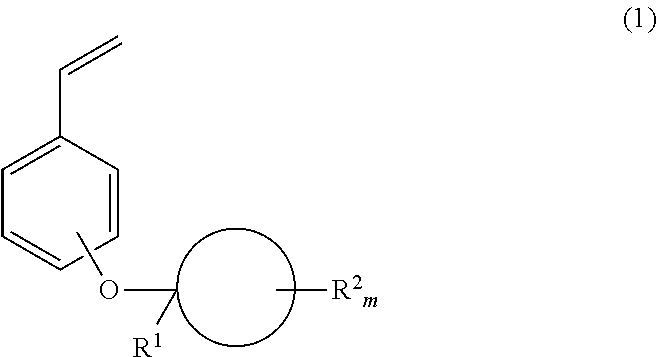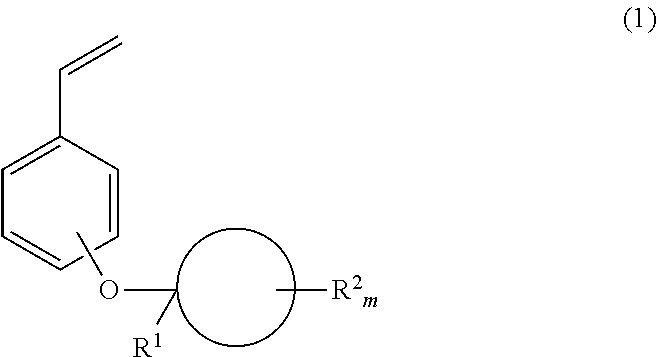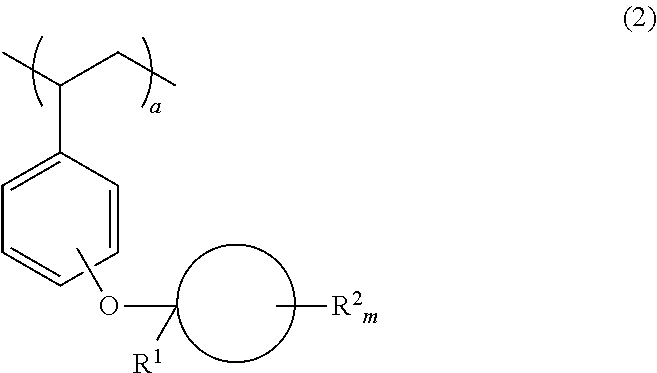Monomer, polymer, positive resist composition and patterning process
a polymer and monomer technology, applied in the field of positive resist composition, can solve the problems of inferior dissolution contrast to carboxylic acid generation type, pattern collapse, etc., and achieve the effects of preventing pattern collapse, reducing the swell of alkaline developer, and high alkaline dissolution rate contras
- Summary
- Abstract
- Description
- Claims
- Application Information
AI Technical Summary
Benefits of technology
Problems solved by technology
Method used
Image
Examples
synthesis example 1-1-1
Synthesis of Bromo Compound 1
[0110]To a mixture of 639.5 g of p-bromophenol, 109.6 g of methyleneadamantane, and 2,700 g of toluene kept below 5° C., 7.1 g of methanesulfonic acid was added. The contents were stirred at the temperature for 15 hours. 591 g of a 25 wt % sodium hydroxide aqueous solution was added to the reaction solution to quench the reaction, from which the organic layer was recovered. The organic layer was washed with water and saturated saltwater, and concentrated, yielding 168.5 g of crude bromo compound 1.
[0111]1H-NMR (600 MHz in CDCl3): δ=1.34 (3H, s), 1.54 (2H, d), 1.70-1.88 (8H, m), 2.04 (2H, s), 2.32 (2H, d), 6.84 (2H, d), 7.31 (2H, d) ppm
synthesis example 1-1-2
Synthesis of Monomer 1
[0112]A Grignard reagent was prepared from 88.7 g of bromo compound 1 (synthesized in Synthesis Example 1-1-1), 7.7 g of magnesium and 160 mL of tetrahydrofuran before it was added to a suspension of 52.6 g of zinc chloride in 700 mL of tetrahydrofuran kept below 40° C. The contents were stirred at the temperature for 1 hour, yielding an organozinc reagent. This reagent was added dropwise to a solution of 44.3 g of vinyl bromide and 1.2 g (1 mmol) of tetrakis(triphenylphosphine)palladium(0) in 700 mL of tetrahydrofuran at 40° C. After the completion of dropwise addition, the solution was aged for 30 minutes. The reaction solution was poured into a saturated ammonium chloride aqueous solution, followed by extraction with ethyl acetate in a standard way. The resulting crude product was purified by vacuum distillation, obtaining 53.4 g of the target compound (yield 72%).
[0113]b.p.: 125-126° C. / 16 Pa
[0114]1H-NMR (600 MHz in CDCl3): δ=1.38 (3H, s), 1.55 (2H, d), 1.7...
PUM
| Property | Measurement | Unit |
|---|---|---|
| size | aaaaa | aaaaa |
| temperature | aaaaa | aaaaa |
| reaction time | aaaaa | aaaaa |
Abstract
Description
Claims
Application Information
 Login to View More
Login to View More - R&D
- Intellectual Property
- Life Sciences
- Materials
- Tech Scout
- Unparalleled Data Quality
- Higher Quality Content
- 60% Fewer Hallucinations
Browse by: Latest US Patents, China's latest patents, Technical Efficacy Thesaurus, Application Domain, Technology Topic, Popular Technical Reports.
© 2025 PatSnap. All rights reserved.Legal|Privacy policy|Modern Slavery Act Transparency Statement|Sitemap|About US| Contact US: help@patsnap.com



